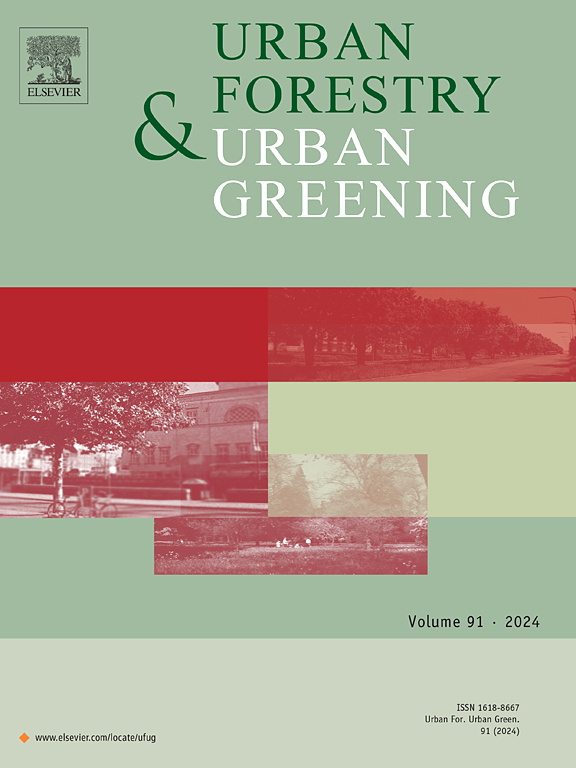Toward low-maintenance extensive green roofs: A review for plant selection and substrate design
IF 6
2区 环境科学与生态学
Q1 ENVIRONMENTAL STUDIES
引用次数: 0
Abstract
Extensive green roofs (EGRs) are gaining popularity worldwide due to their environmental and economic benefits. A primary goal of EGRs is to achieve low maintenance to reduce costs; however, this is often challenged by harsh environmental stresses and limited substrate depth. These challenges can be mitigated through strategic plant selection and substrate design. Despite substantial research on plants and substrates under natural or controlled low-maintenance conditions, a consensus on optimal strategies low-maintenance EGRs (LEGRs) remains elusive. This study reviews 87 articles related to LEGRs, focusing on plant selection and substrate design. Plant selection is evaluated based on three criteria: ecophysiological characteristics, origin status, and establishment. Plant life form, such as forbs, grasses, and succulents, prove effective, with sedums remaining highly suitable for LEGRs. Native plants are gaining attention, while spontaneous plants may provide long-term advantages. Substrates composed of traditional lightweight materials with low organic content support plant performance on LEGRs, with a substrate depth of 10–15 cm being sufficient for sustainable LEGRs. Over 40 % of LEGRs require no maintenance, while low maintenance primarily focuses on irrigation. These findings suggest that LEGRs can succeed in most temperate regions. By integrating plant selection, substrate design, and maintenance strategies, we propose a conceptual framework to facilitate the success of LEGRs. This review offers a valuable reference for implementing LEGRs and the proposed framework can benefit LEGR designers, owners, and stakeholders.
走向低维护的大面积绿色屋顶:植物选择和基材设计综述
广泛的绿色屋顶(egr)由于其环境和经济效益而在世界范围内越来越受欢迎。egr的主要目标是实现低维护以降低成本;然而,这经常受到恶劣环境应力和有限基材深度的挑战。这些挑战可以通过战略性的植物选择和基材设计来缓解。尽管在自然或可控低维护条件下对植物和底物进行了大量研究,但对低维护egr (legr)的最佳策略仍未达成共识。本研究综述了87篇与低碳再生材料相关的文献,重点介绍了植物选择和底物设计。植物选择是根据三个标准进行评估的:生态生理特征、原产地状况和建立。植物的生命形式,如植物、草和多肉植物,被证明是有效的,其中景天仍然非常适合legr。原生植物正在获得关注,而自然植物可能提供长期优势。由低有机含量的传统轻质材料组成的基材支持植物在legr上的性能,基材深度为10-15 cm就足以实现可持续的legr。超过40% %的legr不需要维护,而低维护主要集中在灌溉上。这些发现表明,legr可以在大多数温带地区取得成功。通过整合植物选择、基质设计和维护策略,我们提出了一个概念性框架,以促进legr的成功。这项审查为实施LEGR提供了有价值的参考,拟议的框架可以使LEGR设计者、业主和利益相关者受益。
本文章由计算机程序翻译,如有差异,请以英文原文为准。
求助全文
约1分钟内获得全文
求助全文
来源期刊

Urban Forestry & Urban Greening
FORESTRY-
CiteScore
11.70
自引率
12.50%
发文量
289
审稿时长
70 days
期刊介绍:
Urban Forestry and Urban Greening is a refereed, international journal aimed at presenting high-quality research with urban and peri-urban woody and non-woody vegetation and its use, planning, design, establishment and management as its main topics. Urban Forestry and Urban Greening concentrates on all tree-dominated (as joint together in the urban forest) as well as other green resources in and around urban areas, such as woodlands, public and private urban parks and gardens, urban nature areas, street tree and square plantations, botanical gardens and cemeteries.
The journal welcomes basic and applied research papers, as well as review papers and short communications. Contributions should focus on one or more of the following aspects:
-Form and functions of urban forests and other vegetation, including aspects of urban ecology.
-Policy-making, planning and design related to urban forests and other vegetation.
-Selection and establishment of tree resources and other vegetation for urban environments.
-Management of urban forests and other vegetation.
Original contributions of a high academic standard are invited from a wide range of disciplines and fields, including forestry, biology, horticulture, arboriculture, landscape ecology, pathology, soil science, hydrology, landscape architecture, landscape planning, urban planning and design, economics, sociology, environmental psychology, public health, and education.
 求助内容:
求助内容: 应助结果提醒方式:
应助结果提醒方式:


